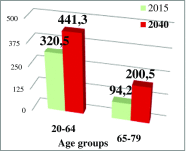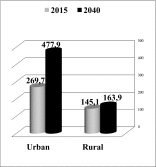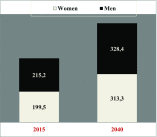Diabetes care in figures: current pitfalls and future scenario
- PMID: 29896313
- PMCID: PMC5972141
- DOI: 10.1007/s13167-018-0133-y
Diabetes care in figures: current pitfalls and future scenario
Abstract
Diabetes mellitus (DM) epidemic-on a global scale-is a major and snowballing threat to public health, healthcare systems and economy, due to the cascade of pathologies triggered in a long-term manner after the DM manifestation. There are remarkable differences in the geographic disease spread and acceleration of an increasing DM prevalence recorded. Specifically, the highest initial prevalence of DM was recorded in the Eastern-Mediterranean region in 1980 followed by the highest acceleration of the epidemic characterised by 0.23% of an annual increase resulted in 2.3 times higher prevalence in the year 2014. In contrast, while the European region in 1980 demonstrated the second highest prevalence, the DM epidemic developments were kept much better under control compared to all other regions in the world. Although both non-modifiable and modifiable risk factors play a role in DM predisposition, cross-sectional investigations recently conducted amongst elderly individuals demonstrate that ageing as a non-modifiable risk factor is directly linked to unhealthy lifestyle as a well-acknowledged modifiable risk factor which, in turn, may strongly promote ageing process related to DM even in young populations. Consequently, specifically modifiable risk factors should receive a particular attention in the context of currently observed DM epidemic prognosed to expand significantly over 600 million of diabetes-diseased people by the year 2045. The article analyses demographic profiles of DM patient cohorts as well as the economic component of the DM-related crisis and provides prognosis for future scenarios on a global scale. The innovative approach by predictive diagnostics, targeted prevention and treatments tailored to the person in a suboptimal health condition (before clinical onset of the disease), as the medicine of the future is the most prominent option to reverse currently persisting disastrous trends in diabetes care. The key role of biomedical sciences in the future developments of diabetes care is discussed.
Keywords: Adolescence; Comorbidities; Costs; Diabetes mellitus; Economy; Epidemic; Health policy; Medical care; Pitfalls; Predictive preventive personalised medicine; Prevalence; Prognose.
Conflict of interest statement
Compliance with ethical standardsThe authors declare that they have no conflict of interest.Patients have not been involved in the study.No experiments have been performed including patients and/or animals.
Figures






References
-
- Golubnitschaja O. In: Three levels of prediction, prevention and individualised treatment algorithms to advance diabetes care: integrative approach. pp. 11–28. In book New Strategies to Advance Pre/Diabetes Care: Integrative Approach by PPPM. Mozaffari M, editor. Dordrecht: Springer; 2013.
-
- World Health Organization. Global report on diabetes. 2016; ISBN 978 92 4 156525 7,http://apps.who.int/iris/bitstream/10665/204871/1/9789241565257_eng.pdf?... viewed on February 1st 2018.
-
- Parkkola A, Laine AP, Karhunen M, Härkönen T, Ryhänen SJ, Ilonen J, Knip M, Register FPD. HLA and non-HLA genes and familial predisposition to autoimmune diseases in families with a child affected by type 1 diabetes. PLoS One. 2017;12(11):e0188402. doi: 10.1371/journal.pone.0188402. - DOI - PMC - PubMed
Publication types
LinkOut - more resources
Full Text Sources
Other Literature Sources

